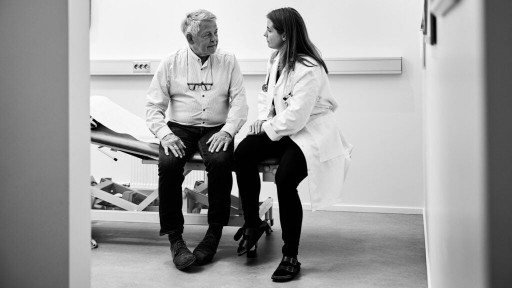
- Experts say many adults who develop type 1 diabetes are being misdiagnosed as having type 2 diabetes.
- They say this is happening in part because many medical professionals see type 1 diabetes as something that is diagnosed in childhood.
- They point out that symptoms for both types of diabetes are similar, but treatment plans are quite different.
Experts say more adults are being misdiagnosed with type 2 diabetes when they actually have type 1 diabetes.
For decades, type 1 diabetes was known as “juvenile diabetes” and believed to only develop during childhood.
“Misdiagnosis of type 1 diabetes as type 2 diabetes occurs far too often,” explained Gary Scheiner, MS, CDCES, the owner and clinical director of Integrated Diabetes Services.
“I believe it is a simple matter of ignorance on the part of emergency medical personnel who assume that type 1 only develops in childhood and that overweight individuals must have type 2,” Scheiner told Medical News Today.
“The facts tell us otherwise. According to recent research, more than 50 percent of type 1 diagnoses occur after age 18, and many in middle or older ages. More than a third of all people with type 1 are overweight or obese,” he added.
If you’ve been diagnosed with type 2 diabetes and you either don’t fit the typical profile or your blood sugars continue to rise despite following your treatment plan, you might have been misdiagnosed.
Why the right diagnosis of diabetes is critical
Officials estimate that
However, experts note that the misdiagnosis of type 2 diabetes instead of type 1 diabetes can lead to an ineffective treatment plan, leaving a person with months or years of frustrating high blood sugar levels and an increased risk of diabetes-related complications.
While the symptoms of both types are nearly identical, the cause behind those symptoms is entirely different and requires a different prioritization of treatment options.
Type 2 diabetes is a metabolic disorder in which the body is struggling with increasing insulin resistance due to a mix of genetics, lifestyle habits, and other factors. In type 2 diabetes, the pancreas produces extra insulin but cannot keep up with the demand to maintain normal blood sugar levels. The body has difficulty effectively using that insulin. Over time, insulin production can also decline due to
The usual profile of a person with type 2 diabetes includes being overweight or living with obesity, along with other metabolic factors such as high cholesterol and high blood pressure.
The treatment plan usually starts with improving lifestyle habits (nutrition and exercise), then the drug metformin, and possibly
Type 1 diabetes, on the other hand, is an autoimmune disease. While genetics can play a role,
In type 1 diabetes, the immune system is triggered to attack and destroy the cells in the pancreas that produce insulin. In children, type 1 diabetes progresses quickly and the need for daily insulin therapy is nearly immediate after symptoms are identified.
In many adults, insulin production can decline more slowly, which could delay the need for insulin therapy by years. When caught in the earlier stages, type 1 diabetes can look like type 2 diabetes, but it’s actually “latent autoimmune diabetes in adults,” commonly known as LADA.
Misdiagnosed patients are sometimes put on type 2 medications that seem to help at first — because LADA progresses so slowly — but blood sugars eventually start to rise more aggressively.
“It is important to establish a correct diagnosis, as proper treatment hinges on the nature of the condition,” said Scheiner. “Many people with type 1 who are assumed to have type 2 because of their age or physical characteristics are treated with non-insulin pharmacologics. In the least, this shortens or eliminates the ‘honeymoon’ period of type 1 diabetes in which the pancreas continues to produce some insulin. At worst, it can lead to excessive hyperglycemia, ketoacidosis, and death.”
Misdiagnosed with type 2 diabetes in his late 50s
Peter Bongiorno was shocked when his doctor informed him that his HbA1c was approaching prediabetic levels at 5.5% when he was in his late 50s.
Already physically active, lean, and passionate about nutrition, Bongiorno intensified his daily exercise routine and started a vegetarian diet.
Bongiorno isn’t new to diabetes — his daughter, Lauren Bongiorno, has lived with type 1 diabetes for 25 years and is the founder and chief executive officer of Risely Health, a diabetes coaching company.
However, the Bongiorno family assumed the rest of the family was safe from developing type 1 simply based on their ages.
“Within the next two years, [my Hb1Ac] went up to 5.7 percent,” Bongiorno told Medical News Today. “This scared me into getting even more strict with my diet. I went totally vegan and started checking my blood sugar regularly.”
When his A1c reached 6%, Bongiorno channeled his frustration into stricter nutrition and more exercise. With a fasting blood sugar level of 110 mg/dL, his doctor was also perplexed but encouraged him to focus on his lifestyle habits.
“I lost 20 pounds,” says Bongiorno, who had been reluctant to try any diabetes medications. “But the next year, my A1c was up to 6.3 percent. I couldn’t believe it. Over the next two years, I saw it climb to 7.1 percent. That’s when I finally agreed to try metformin.”
It wasn’t until his daughter got off a call with a client at Risely Health who had been misdiagnosed with type 2 diabetes that it suddenly struck her.
“I was telling my parents about this issue of people being misdiagnosed and then I just realized this was my father’s story, too,” Lauren Bongiorno told Medical News Today. Over the next several months, the Bongiorno family worked with his healthcare team to get tested for the clear indicators of type 1 diabetes.
Getting screened for type 1 diabetes
Thanks to decades of research, identifying type 1 diabetes is relatively simple with a few specific blood tests.
These tests include:
- Autoantibodies: Autoantibodies develop when your immune system is attacking your own body. Research from TrialNet and other organizations have pinpointed specific autoantibodies and can identify them with blood testing. The presence of two more autoantibodies suggests a person is in one of the three stages of developing type 1 diabetes. The earliest stages can develop years before noticeable symptoms develop.
- C-peptide levels: C-peptide indicates how much insulin your pancreas is producing. In people with type 2 diabetes, C-peptide levels are generally quite high. In people with type 1 diabetes, C-peptide levels are usually quite low.
Identifying type 1 diabetes before the need for daily insulin therapy is also critical.
In 2023, the Food and Drug Administration approved the
Clinical trials continue to examine the full potential of the drug.
“While the incidence of proper diagnosis is improving, we still see far too many cases of misdiagnosis,” said Scheiner. “I would estimate that one out of four adult type 1 patients we see at Integrated Diabetes were mistakenly thought to have type 2 at the time of their diagnosis and were placed on ineffective therapies. Type 1 absolutely requires insulin therapy for restoration of healthy metabolic function and survival.”





